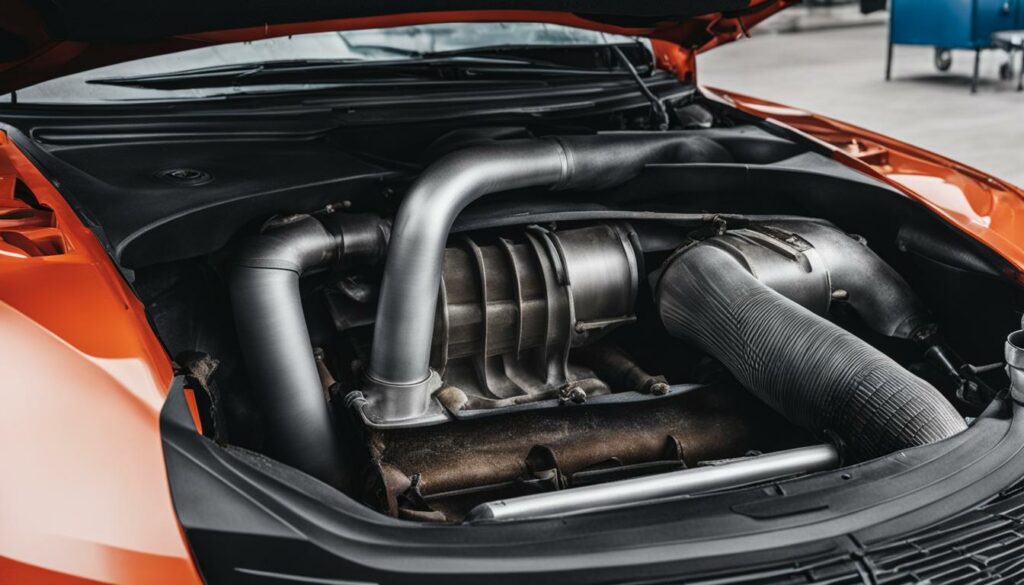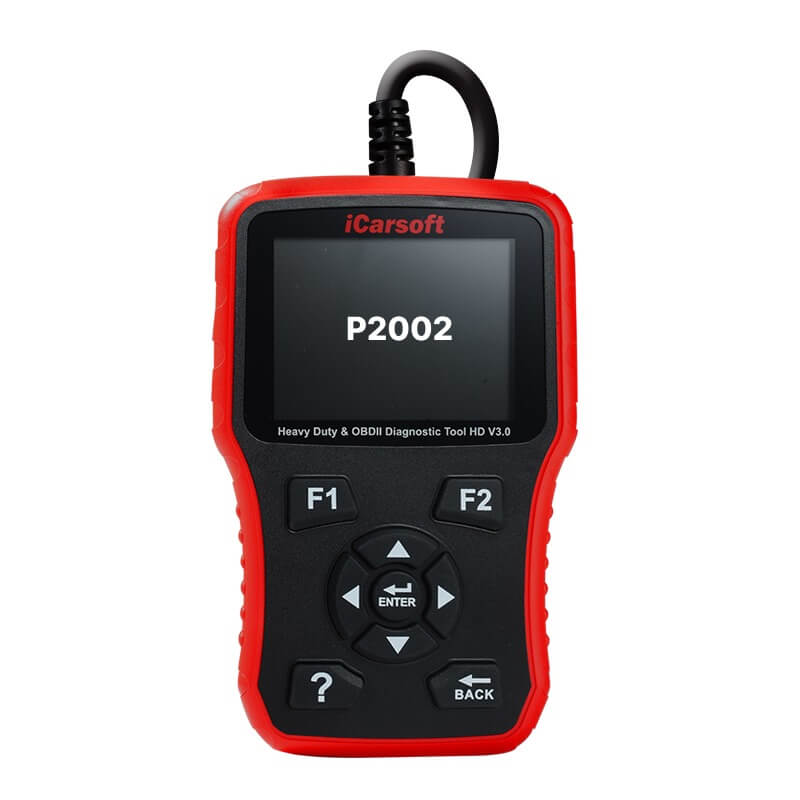Understanding P2002 – DPF Efficiency Below Limit
POSTED IN pcodes
Are you familiar with the P2002 code and its implications for your vehicle’s performance? If not, it’s time to delve into the world of diesel particulate filters (DPF) and understand why an efficiency below limit can be a cause for concern.
The DPF plays a crucial role in the exhaust system of diesel engines, working tirelessly to eliminate harmful soot particles and ensure clean emissions. However, when the DPF is unable to perform efficiently, it can trigger the P2002 code, signaling potential issues that need attention.
So, what exactly does the P2002 code mean? It indicates that the DPF is not functioning optimally, compromising its ability to effectively filter out soot emissions. This can be caused by factors such as DPF failure, exhaust system leaks, or faulty exhaust back pressure sensors.
How can you identify if your vehicle is impacted by the P2002 code? Look out for symptoms such as an illuminated check engine light, reduced fuel efficiency, and even the engine going into limp mode. These indicators serve as a reminder to promptly address the underlying issues to ensure your vehicle’s optimum performance and compliance with emission control standards.
When it comes to vehicle maintenance, understanding the P2002 code and its implications is essential. It allows you to take the necessary steps to rectify the issue and avoid potential long-term damage to your DPF and exhaust system.
Buy tested tuning file for Adblue / EGR / DPF / Adblue off now!
Key Takeaways:
- DPF Efficiency Below Limit (P2002) indicates that the diesel particulate filter is not working optimally, compromising emissions control.
- Symptoms of the P2002 code include an illuminated check engine light and reduced fuel efficiency.
- Potential causes of the P2002 code include DPF failure, exhaust system leaks, and faulty exhaust back pressure sensors.
- Proper diagnosis and timely repairs are crucial for maintaining DPF efficiency and overall vehicle performance.
- Regular vehicle maintenance and adherence to emission control standards are essential to prevent DPF-related issues.
What is a Diesel Particulate Filter?
A diesel particulate filter (DPF) is an emissions control device that is positioned in the exhaust system of a vehicle. It is designed to physically filter out soot and eliminate hydrocarbons from the engine exhaust gases through catalyst reactions. The DPF looks similar to a catalytic converter but has the ability to regenerate or clean itself.
When the engine is running, the exhaust gases pass through the DPF, and the porous ceramic or metal core of the filter traps the soot particles. This process helps reduce harmful emissions and ensures cleaner air quality.
“The DPF is an essential component of the emissions control system, contributing to the overall environmental performance of diesel vehicles.”
Regeneration of the DPF usually occurs automatically when certain conditions are met, such as operating the vehicle at speeds above 40 mph. During the regeneration process, the accumulated soot is burned off, and the DPF is restored to its optimal functioning state.
However, if the DPF cannot regenerate efficiently, the soot particles can build up, leading to reduced exhaust system performance and potential engine problems. This can trigger the P2002 code, indicating that the DPF is not working at its desired efficiency.
DPF Regeneration Process
The regeneration process is vital for the proper functioning of the DPF. It can occur in two ways: active regeneration and passive regeneration.
- Active Regeneration: This process is initiated by the vehicle’s engine control unit (ECU) when the DPF reaches a specific level of soot accumulation. The ECU increases the exhaust temperature, usually by injecting fuel into the engine during the exhaust stroke, to raise the temperature within the DPF. This increased temperature burns off the accumulated soot, resulting in the regeneration of the DPF.
- Passive Regeneration: Passive regeneration occurs when the exhaust gases naturally produce enough heat to burn off the accumulated soot in the DPF. This process typically occurs during prolonged highway driving or when the engine reaches higher temperatures.
It is important to note that factors such as short trips, stop-and-go traffic, or low-speed operation can hinder the DPF regeneration process, leading to a higher risk of DPF clogging and reduced exhaust system efficiency.
The image above illustrates the design of a Diesel Particulate Filter (DPF).
Possible Causes of the P2002 Code
The P2002 code can have various causes that may trigger the DPF Efficiency Below Limit. Understanding these causes can help in diagnosing and resolving the issue effectively. Below are some possible causes of the P2002 code:
- DPF failure or damage: A damaged or malfunctioning diesel particulate filter can lead to reduced efficiency and trigger the P2002 code.
- Exhaust leaks: Leaks in the exhaust system can affect the proper functioning of the DPF, leading to the P2002 code.
- Excessive slow-speed or stop-and-go operation: Continuously operating the vehicle at slow speeds or in stop-and-go traffic conditions can contribute to DPF clogging and trigger the P2002 code.
- Defective exhaust back pressure sensor: A faulty sensor that measures the exhaust back pressure can provide inaccurate information to the engine control module, resulting in the P2002 code.
- Constant short-distance trips: Frequently driving short distances without allowing the DPF to reach the required temperature for regeneration can lead to clogged filters and trigger the P2002 code.
- High sulfur content in fuel: The presence of high sulfur content in the fuel can accelerate DPF clogging, contributing to the occurrence of the P2002 code.
- Software issues: Although rare, software issues within the vehicle’s system can also result in the P2002 code.
Proper diagnosis by a qualified technician is essential to identify the specific cause of the P2002 code and determine the appropriate course of action for repairs.

Expert Insight
“When diagnosing the P2002 code, it’s crucial to consider multiple factors that can lead to its occurrence. Factors such as DPF failure, exhaust leaks, slow-speed operation, and even the sulfur content in fuel can all contribute to the code’s activation. A comprehensive analysis, including visual inspection and testing, is necessary to pinpoint the underlying cause and devise an effective solution.”
Common Symptoms of the P2002 Code
If you encounter the P2002 code, it is essential to identify the associated symptoms to address the issue promptly. Here are the common symptoms related to the P2002 code:
- An illuminated check engine light: The check engine light on your dashboard may illuminate, indicating a problem with the diesel particulate filter (DPF) efficiency.
- Reduced fuel economy: The P2002 code can lead to reduced fuel efficiency, resulting in increased fuel consumption and higher costs.
- Difficulty starting the vehicle: If you experience difficulty starting your vehicle, it could be a symptom of a DPF-related issue.
- Poor acceleration: The engine may exhibit poor acceleration and reduced power output, affecting the overall performance of your vehicle.
- Engine oil dilution: In some cases, the P2002 code can cause engine oil dilution, leading to potential engine damage if left unaddressed.
- Limp home mode: The engine management system may engage limp home mode, also known as de-rated mode, as a protective measure to prevent further damage.
When the DPF fails to regenerate properly, the engine management system may increase the exhaust temperature to burn off accumulated soot, which can result in increased engine activity and decreased performance.
Diagnosing the P2002 Code
When facing the P2002 code, a thorough diagnostic process is essential to pinpoint the root cause accurately. Several key steps can help in diagnosing this issue:
- Visual Inspection: Perform a visual inspection of the Diesel Particulate Filter (DPF) and the associated wiring. Look for any visible signs of damage, such as cracks or leaks.
- Back Pressure Sensor Readings: Connect an OBD-II scanner and take the vehicle for a test drive. Monitor the back pressure sensor readings and compare the values between bank 1 and bank 2. Any significant discrepancies can indicate a faulty sensor or a potential DPF replacement.
- Exhaust Leak Check: Inspect the entire exhaust system for any leaks or loose connections. A leak in the exhaust system can affect the DPF’s efficiency, triggering the P2002 code.
- Sensor Functionality Verification: Test the functionality of the back pressure sensor to ensure it is operating correctly. Refer to the vehicle’s technical documentation for detailed instructions on how to perform this test accurately.
By following these diagnostic steps, you can narrow down the potential causes of the P2002 code and identify the specific components that require attention.
Additionally, refer to the table below for a summarized overview of the diagnostic steps:
| Diagnostic Steps | Actions |
|---|---|
| Visual Inspection | Inspect the DPF and associated wiring for damage. |
| Back Pressure Sensor Readings | Use an OBD-II scanner to monitor and compare sensor values. |
| Exhaust Leak Check | Inspect the entire exhaust system for leaks. |
| Sensor Functionality Verification | Test the back pressure sensor to ensure proper functionality. |

Fixing the P2002 Code
Fixing the P2002 code can involve various steps depending on the specific issue. To address the problem and resolve the code, consider the following solutions:
- Clearing the DPF: In some cases, a simple cleaning of the diesel particulate filter (DPF) can resolve the issue. If poor fuel quality caused temporary fouling, clearing the DPF can help restore its efficiency.
- Improving fuel quality: Changing to a higher quality diesel fuel can contribute to preventing future issues with the DPF. By using cleaner fuel, the risk of clogging and triggering the P2002 code can be reduced.
- Replacing faulty components: If the DPF or the back pressure sensor is determined to be faulty or damaged, replacement may be necessary. A malfunctioning sensor can lead to incorrect readings and trigger the P2002 code, while a damaged DPF may not be able to filter out soot effectively.
- Performing DPF cleaning or regeneration: Implementing DPF cleaning or regeneration procedures can help address issues with the filter’s efficiency. These procedures facilitate the removal of accumulated soot, allowing the DPF to function optimally.
- Addressing exhaust leaks: If there are any exhaust leaks present, they should be promptly repaired or replaced. Leaks in the exhaust system can contribute to decreased DPF performance and may need to be addressed as part of the solution.
By following these steps and implementing the appropriate fixes, you can effectively resolve the P2002 code and ensure the proper functioning of your DPF and the overall performance of your vehicle.
Conclusion
Understanding the P2002 code and the role of the Diesel Particulate Filter (DPF) in your vehicle’s exhaust system is crucial for maintaining DPF efficiency and ensuring proper vehicle maintenance. When you experience symptoms such as an illuminated check engine light, it is important to diagnose the issue accurately to determine the exact cause of the P2002 code.
By addressing the problem promptly and with a proper diagnosis, you can ensure timely repairs and prevent further damage to your vehicle. Whether it involves DPF cleaning, sensor replacement, or other necessary fixes, taking proactive steps will help maintain the efficiency of your DPF and overall vehicle performance.
Remember, when it comes to the P2002 code, timely repairs and attention to vehicle maintenance are key. By taking proper care of your vehicle and performing necessary repairs, you can prevent further issues and keep your check engine light from reappearing. Don’t ignore the symptoms and address any P2002 code issues promptly, so you can continue to enjoy safe and efficient driving.
FAQ
What does the P2002 code mean?
The P2002 code indicates that the diesel particulate filter (DPF) is not working efficiently in removing soot from the exhaust gases of the vehicle’s diesel engine.
What is a diesel particulate filter (DPF)?
A DPF is an emissions control device that is positioned in the exhaust system of a vehicle. It physically filters out soot and eliminates hydrocarbons from the engine exhaust gases through catalyst reactions.
What are the possible causes of the P2002 code?
The P2002 code can be caused by various issues, including DPF failure or damage, exhaust leaks, excessive slow-speed or stop-and-go operation of the vehicle, a defective exhaust back pressure sensor, constant short-distance trips, stop-and-go traffic, and high sulfur content in the fuel.
What are the common symptoms of the P2002 code?
Common symptoms of the P2002 code include an illuminated check engine light, reduced fuel economy, difficulty starting the vehicle, poor acceleration, engine oil dilution, and the engine going into limp home mode.
How is the P2002 code diagnosed?
Diagnosing the P2002 code requires a visual inspection of the DPF and the back pressure sensor, as well as associated wiring. A test drive with an OBD-II scanner connected can help track back pressure sensor readings and determine the cause. Checking for any exhaust leaks and verifying the functionality of the sensor are also important steps.
How is the P2002 code fixed?
Fixing the P2002 code can involve various steps depending on the specific issue. Clearing the DPF can sometimes resolve the problem, changing to higher quality diesel fuel can help prevent future issues. If the DPF or the back pressure sensor is faulty, they may need to be replaced. Performing DPF cleaning or regeneration procedures and replacing any exhaust leaks can also be part of the fix.
Why is it important to address the P2002 code promptly?
Addressing the P2002 code promptly is important to ensure the efficiency of the DPF and overall vehicle performance. Ignoring the code can lead to increased engine activity, reduced performance, and potential damage to other components of the vehicle’s emission control system.


